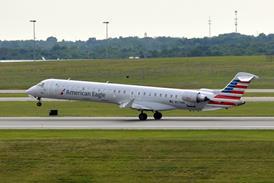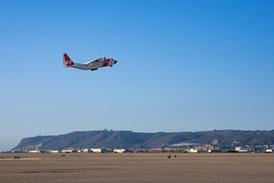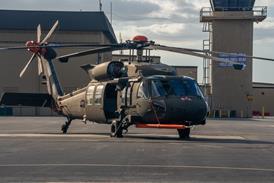GUY NORRIS / RENO
Airframes shaping, thin unswept wings, surface roughness and energy beams are all promising methods of reducing sonic boom
Research sponsored by the US Defense Advanced Research Projects Agency (DARPA) suggests low sonic boom supersonic aircraft could be practical. Initial results of the ground-breaking research were presented last week at the American Institute of Aeronautics and Astronautics annual aerospace sciences conference in Reno, Nevada.
Shaping up
University of Colorado research reveals that slight changes to the dihedral, sweep and twist of wings and control surfaces have "a significant effect on sonic boom performance". The results follow investigation into minimising the initial shock pressure rise through optimisation of the shape of Lockheed Martin's "point of departure" design for DARPA's Quiet Supersonic Platform (QSP). Changes were made using a computational shaping method.
Lockheed Martin's conceptual aircraft is 39m (128.5ft) long and weighs 44,500kg (98,000lb). Various shape changes were analysed for the aircraft flying at Mach 1.5 and 45.000ft, at an angle of attack of 0.7º. In these conditions, baseline overpressure was 0.75millibar (1.6lb/ft2), or roughly 5.4 times higher than the limit specified by DARPA (Flight International, 15-21 January).
Through shape changes, the team demonstrated a ten-fold reduction in initial pressure rise while maintaining constant lift and wave drag. Final changes included tilting the nose down and sweeping the canard surfaces forward. These were also twisted forward and down and the wing swept forward and tilted down.
Researchers say tilting the nose has a minor effect on sonic boom performance, as does the position of the canard. These changes jointly contributed to 8.5% of the improvement, while changes to the dihedral, sweep and twist of the canard and wing produced a combined 56% change. Further tests will investigate the influence of other parameters such as wing camber, as well as using the method to further improve the fuselage itself.
Smooth supersonics
Researchers working under DARPA-sponsored efforts into supersonic laminar flow control (SLFC) believe a low-boom design could be developed by combining low-swept wings with a flow-control concept using distributed surface roughness.
Flight tests of a small-scale test blade with zero sweep on a NASA Boeing F-15 generated full-chord natural laminar flow at supersonic speeds over around 80% of the representative wing. However, configurations using unswept wings do not easily meet the QSP low-boom target and a revised version, with increased dihedral and a vertically offset canard, has shown lower boom potential, say researchers.
The SLFC team, based at California's Stanford University and Reno Aeronautical of Nevada, also took this optimised shape a step further and devised a more promising "hybrid" design featuring a slightly swept wing with supersonic leading edges. To ensure adequate control against the cross- flow instability found on most swept wing designs, the team is proposing adopting an SLFC technique using surface roughness.
Arizona State University evaluations indicate a distributed pattern of surface roughness along the leading edge can control the highly unstable boundary layer in supersonic flow. The technique, in which µm-size roughness elements are placed close to the leading edge, produces a laminar-flow boundary layer across 80% of the chord and the potential for up to 25% lower fuel consumption. The team believes the drag reduction can translate directly into weight reductions that reduce boom.
"It is only effective if applied to the leading edge, or between 2% and 5% of the chord, and the height of the surface roughness is kept quite low," says researcher Helen Reed. The team tested sections covered with 30µm thick appliqué in which were drilled 200µm diameter, 12µm deep holes. Spaced every 1.7mm to 1.9mm apart, they "worked just as well - which is why golf balls work so well", adds fellow researcher William Saric.
Power projection
A combined Princeton University and Boeing Phantom Works team has demonstrated the theoretical feasibility of using off-board energy projection to reduce sonic boom intensity.
"We focused on whether energy addition works and the answer is 'yes'," says researcher Richard Miles. Results indicate that "energy addition can, indeed, reduce the far-field signature primarily by suppressing the far-field coalescence of the various shock waves originating from the different parts of the vehicle".
The concept involves projecting energy ahead of the aircraft to form a localised hot-spot in the atmosphere. The explosive energy generates a bow shock ahead of the aircraft's actual bow shock. The result is an increased "virtual" aircraft length which causes pressure waves to spread further. This slows the rise time and reduces the overpressure of far-field" N-waves", both of which decrease the perceived strength of the sonic boom.
Following mathematical modelling of the effect, the team also demonstrated the theoretical benefit of pulsing the energy in front of the aircraft. "This really changes the virtual size of the aircraft back and forth and, in tests of a simple wedge model, showed a 20% drop in overpressure," says Miles. Pulsing drops the total power requirement by a factor of four."
Small-scale tests were performed in a Mach 2.4-capable windtunnel, in which a laser fired a 0.375J, 10ns pulse into the flow upstream of the model every 2.5ms at a frequency of 125Hz. The team also evaluated potential full-scale power projection configurations. One of the best appears to be an array of four 2 x 2m projectors under the forward fuselage. Emitting at 30GHz, this would project around 49MW power to a "breakdown" spot about 1.05m in diameter, 46m forward and below the aircraft.
While larger-scale tests to validate the effect are planned, Miles cautions that early tests have not been "as encouraging as I'd like". He also stresses DARPA's QSP goals will only be met by combining energy addition with shape optimisation.
Source: Flight International























